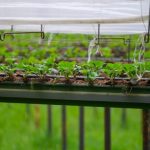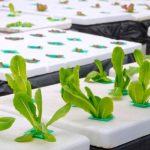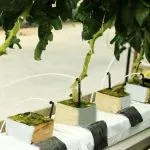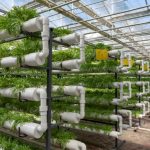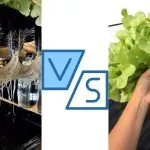Deep Water Culture hydroponics, or DWC, is a hydroponic system that sustains plant roots in a well-oxygenated solution full of nutrients and water 24/7. This method differs from other hydroponic techniques, such as Ebb and Flow, Aeroponics, and Drip Systems, where plants are watered on a regular basis but not continuously submerged. With DWC, your plants thrive in an environment that promotes faster growth, better nutrient absorption, and improved overall plant health.
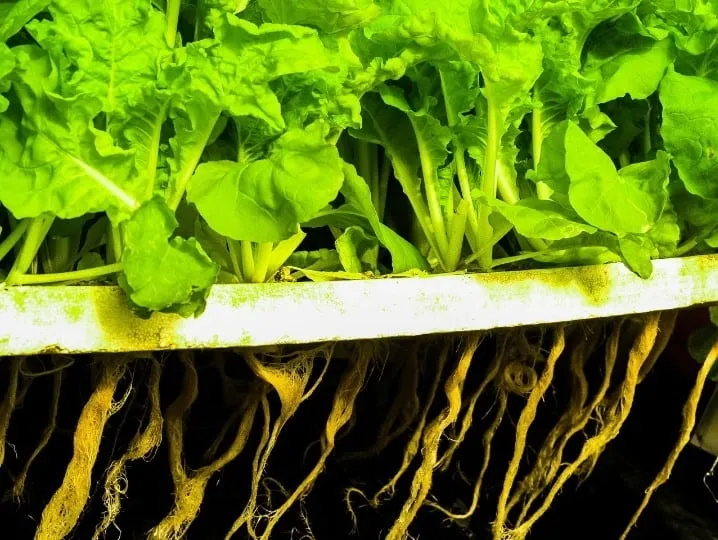
As you delve into the world of Deep Water Culture systems, you’ll find that the process is simpler than it initially appears. By immersing yourself in this unique and innovative growing technique, you’re opening the door to a whole new world of gardening possibilities. Get ready to experience increased yields, less maintenance, and an exciting new way to nurture your favorite plants.
Understanding Deep Water Culture
What is DWC?
Deep Water Culture (DWC), also called floating raft technology (FRT), is a hydroponic growing method in which the roots of plants are suspended in a well-oxygenated, nutrient-rich water solution. In this technique, the roots receive steady oxygen, water, and nutrients for optimal plant growth.
With DWC, you eliminate the need for substrate growing media. Instead, your plants’ roots dangle directly into the reservoir, absorbing all the necessary components for healthy growth directly from the solution. Keep in mind that you will most likely need growing media to fill the net cups that hold each plant.
DWC Vs. Traditional Hydroponics
Compared to traditional hydroponic systems like Ebb and Flow, Aeroponics, and Drip System, Deep Water Culture has a few key differences:
- In DWC systems, the plant roots are always submerged in the water while other techniques water the plants on a consistent basis. Therefore you need an air pump to ensure a continuous oxygen supply instead of a water pump.
- Oxygenation is constantly maintained in the DWC reservoir, providing ample oxygen supply for the roots.
Some advantages of using Deep Water Culture hydroponics over traditional hydroponics include:
- Faster plant growth: Thanks to the constant supply of nutrients, water, and oxygen, your plants can grow faster in DWC systems.
- Simplicity: DWC systems are relatively simple to set up and maintain, requiring less involvement in providing nutrients and water.
- Water efficiency: Deep Water Culture systems can be more water-efficient than traditional hydroponic systems, as the water is constantly being recycled.
- Lower risk of pests and diseases: With no soil or substrate growing media involved, the chances of encountering pests and diseases are significantly reduced.
However, DWC systems also come with some challenges:
- Oxygenation: Ensuring proper oxygenation in your reservoir can be challenging, and if not managed effectively, the plants can actually drown or it can lead to root rot and other plant health issues.
- Monitoring and adjusting nutrient levels: Regularly monitoring and adjusting the nutrient levels in the reservoir is essential for optimal plant growth.
By understanding the Deep Water Culture technique, its differences from traditional hydroponics, and deep water culture advantages and disadvantages, you can determine whether this method is right for your specific needs and growing environment. Just remember to pay attention to oxygenation and nutrient management to keep your plants healthy and thriving.
Components of a DWC System
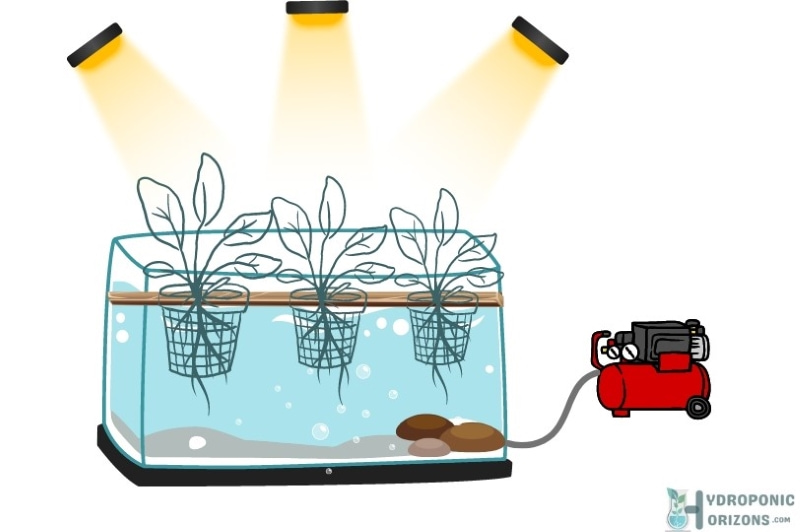
Reservoir
Your DWC hydroponic system will need a reservoir to hold the nutrient-rich water solution for your plants. This container should be made of durable, lightproof material to prevent algae growth and protect your plant roots from light. Choose a reservoir size that accommodates the number of plants you want to grow and the size of their root systems. If you want to start a budget system, there’s nothing better than a DIY hydroponic 5 gallon bucket. Keeping an eye on DWC water levels in reservoirs is important, since there is no timed circulation through the system.
Air Pump
An essential component of a DWC system is the air pump. The air pump provides oxygen to the roots, as they are submerged in water instead of soil. Oxygenation ensures that your plants don’t drown and promotes overall plant health. Select an air pump with a flow rate that matches the size of your reservoir and the oxygen demands of your plants.
Air Stone
Connected to the air pump, the air stone disperses the oxygen bubbles throughout the reservoir. This ensures an even distribution of oxygen, making it more accessible to the plant roots. Air stones come in various shapes and sizes, and you may need more than one, depending on the size of your reservoir.
Net Pots
Net pots are the containers that hold your plants in the DWC system. They allow the plant roots to grow through and reach the nutrient-rich water solution. These pots should be made of sturdy, plastic mesh or other materials that promote proper drainage, aeration, and support for the roots. Choose net pots that can accommodate the size of your plants and the growth of their roots.
Water and Nutrients
In a DWC system, plants rely on a well-oxygenated water and nutrient solution for their growth. You need to provide your plants with the right balance of nutrients, depending on their specific requirements. Monitor the pH levels and adjust as needed to ensure optimal nutrient uptake.
To sum up, the components of a DWC system include a reservoir, air pump, air stone, net pots, and water mixed with nutrients. Each of these components plays a crucial role in the success of your hydroponic system.
Growing in a DWC System

Plant Selection
When you start your Deep Water Culture hydroponic journey, your first step is selecting the right plants. Many plants can grow well in DWC systems, such as lettuce, herbs, and tomatoes. However, it’s crucial to choose plants that naturally have high water needs and can adapt to this system.
Accelerated Growth and Yield
One of the many benefits of using a DWC system is the accelerated growth rates and improved yields compared to traditional soil-based growing. The plants have better access to oxygen and nutrients in the DWC setup, enabling them to focus more on growth and less on root development. As a result, some plants can grow as much as 10cm in one day! The rapid growth and good resource availability contribute to larger harvests, making DWC an appealing choice for many gardeners.
Monitoring and Maintenance
When learning how to grow deep water culture plants, proper monitoring and maintenance are essential for success in your DWC system. Keeping an eye on factors like oxygen, nutrients, and water levels is crucial for maintaining healthy plants. To ensure adequate oxygen supply, invest in a high-quality air pump and airstone, which will create bubbles and circulate the nutrient-rich water. This will help prevent your plants from “drowning” in the DWC system.
Another key aspect is maintaining the nutrient levels in your reservoir. Routinely check for pH fluctuations and adjust the nutrients as necessary. Aim to change the nutrient solution every two weeks or monitor the electrical conductivity (EC) levels to ensure the plants are receiving the right amount of nutrients.
You should also clean your system periodically to prevent algae growth and maintain proper functioning and top off the reservoir with fresh water as needed.
Water and Nutrient Management
Water Temperature
In your Deep Water Culture (DWC) system, you should maintain a proper water temperature. Ideally, the water temperature should be within the range of 65-75°F (18-24°C). Water temperatures in this range encourage healthy root growth and prevent root diseases. If the water gets too hot or too cold, your plants may suffer from stress or have slow growth. To control your DWC water temperature, you can use a water heater, a water chiller, or air condition the growing environment, depending on your specific needs.
Water Level
The water level in a DWC system plays a crucial role in fostering optimal root growth. It’s important to ensure that the water level in the reservoir is suitable for your plants. As a general rule of thumb, try to maintain the water level about 1-2 inches below the base of your plant’s net pot. This will allow your plants to form a dry zone at the top of the roots so they can absorb oxygen more efficiently. Monitor the water level regularly, and adjust it as needed. This will prevent your plant roots from being exposed to too much or too little water.
Nutrient Concentration
To give your plants the necessary nutrients for growth, you will need to provide a well-balanced nutrient solution in your DWC system. Keep the nutrient concentration at a suitable level. Overfeeding your plants can lead to nutrient lockout, where the plants are unable to absorb the essential nutrients they need. On the other hand, underfeeding can restrict growth or even cause deficiencies. It’s crucial to strike a balance so that your plants have the proper amount of nutrients. To achieve this, use a reliable TDS (Total Dissolved Solids) or EC (Electrical Conductivity) meter to monitor your nutrient solution regularly.
pH Levels
Managing the pH levels in your DWC system is essential. A pH between 5.5 and 6.5 is ideal for most plants; it allows them to absorb nutrients more efficiently. To keep your pH levels in the desired range, you’ll need to test the pH of your nutrient solution regularly. To adjust the pH levels, you can use pH up or pH down products. Consistently maintaining the pH levels in your DWC system will help maximize nutrient uptake and ensure healthy plant growth.
Popular DWC Variations

In this section, we will discuss popular variations of Deep Water Culture (DWC) hydroponics in brief. These include Traditional DWC, Recirculating DWC, Kratky Method, and Bubbleponics. Each method is unique and can be utilized depending on your needs and preferences.
Traditional DWC
The Traditional DWC is a simple form of a deep water culture system where your plants have their roots suspended in an oxygenated nutrient solution. To set up this system, you’ll need:
- A 5-gallon bucket
- An air pump
- An air stone
- Air tubing
- Net pots
- Growing media
- Hydroponic nutrients
Your plants will grow directly in this nutrient-rich water, utilizing the dissolved oxygen provided by the air stone to ensure proper growth without needing soil.
Recirculating DWC
Recirculating DWC is an upgrade to the traditional DWC method, where multiple containers are interconnected, allowing the nutrient solution to be shared among all the plants. This means that you will only need one main reservoir to hold the water and nutrients, making it easier to maintain and change the solution. Additionally, this method helps to minimize waste and can maintain a consistent nutrient balance for your plants.
Related: Want to know whether DWC or RDWC hydroponics is right for you? Find out!
A variation in the RDWC method is the Dutch Bucket method where each individual grow container holds a grow medium instead of aerated water and nutrient-rich water is fed to each plant in the containers from the top. The used water is recirculated back to the main reservoir.
Kratky Method
The Kratky method is a non-circulating hydroponic system that requires no electricity. In this method, you will fill a container with a nutrient-rich water solution, allowing your plants to grow without requiring air pumps or air stones. As the plants consume the nutrients, the water level decreases, providing the roots with oxygen from the air space above the water. This makes it an excellent choice for off-grid or low-energy gardening situations.
Bubbleponics
Bubbleponics, also known as “Top Drip” or “Top Feeding,” is a DWC technique that combines the benefits of traditional DWC and Aeroponics. In this method, plants are suspended in net pots with an oxygenated nutrient solution at the bottom while also receiving nutrient-rich water delivered through a drip system from the top. This ensures that the plants get a continuous supply of oxygen and nutrients, leading to faster growth and better nutrient absorption.
We go into more detail about each of these DWC systems in this guide. Remember to choose the DWC variation that suits your specific needs, space, and resources. These methods offer flexibility and adaptability, making it possible for you to grow your favorite plants with ease and success. If you want to buy a complete kit, we’re here to help you choose the best deep water culture system for your needs.
Best Plants For Deep Water Culture
Lettuce
Lettuce is one of the most popular crops for DWC systems due to its small and lightweight nature. These characteristics make it the perfect fit for growing on rafts. Additionally, it grows quickly, allowing for a continuous harvest. Some of the best lettuce varieties for DWC systems include:
- Butterhead
- Romaine
- Green leaf
- Red leaf
Tomatoes
While tomatoes are larger and may require more effort than lettuce, they can still be successfully grown in DWC systems. However, due to their top-heavy nature, make sure to provide proper support for your tomato plants to prevent them from falling over or breaking at the stem. Some great tomato varieties for DWC systems include:
- Cherry tomatoes
- Roma tomatoes
- Early Girls
- Beefsteaks
Herbs
Herbs are another excellent choice for DWC systems due to their rapid growth rate and ability to be harvested while young and small. They provide a variety of flavors and can be grown year-round in DWC systems. Some popular herbs to grow in DWC systems are:
- Basil
- Oregano
- Mint
- Cilantro
Spinach
Spinach is a versatile and nutritious leafy green that can be grown successfully in DWC systems. It grows quickly and can be harvested multiple times throughout its growth cycle. Spinach varieties suitable for DWC systems include:
- Baby spinach
- Bloomsdale Long Standing
- Savoy
- Giant Nobel
Cucumbers
Cucumbers can be grown in DWC systems with a bit of extra support due to their vining nature. They require a lot of water, making them an ideal match for DWC systems. As for cucumber varieties to grow in a DWC system, consider:
- Armenian cucumbers
- English cucumbers
- Lemon cucumbers
- Marketmore 76

